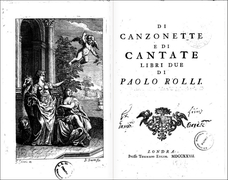New Insight on Maurice Greene's Italian Vocal Music
Monday, October 9, 2017

A recent article by Michael Talbot has shed some light on the “Italian” vocal music of Maurice Greene (1696-1755) and has uncovered two previously overlooked works. Moreover, Talbot identified a handful of pieces that were previously anonymous in RISM.
In “Maurice Greene’s Vocal Chamber Music on Italian Texts” (Royal Musical Association Research Chronicle 48 [2017], p. 91-124), Talbot focuses on the two manuscripts that transmit the majority of Greene’s 37 Italian-language compositions, MS. Mus. d.52 at the Bodleian Library in Oxford (GB-Ob; RISM ID no. 800159943) and A.Ms.3728 at the Bibliomediateca dell’Accademia nazionale di S. Cecilia in Rome (I-Rama, RISM ID no. 850032891). Individual pieces also appear in three other British manuscripts, four of which were anonymous in RISM until now (RISM ID no. 806156974, 806156972, 806252615, and 806252616).
Surprisingly, previous studies about Greene have overlooked two completely separate works in the Oxford manuscript: apparently in two instances it is not quite obvious where one piece ends and the other begins, but Talbot discovered that there are in fact 37 pieces in this manuscript instead of 35. One seems to be unique to this manuscript, the cantata “Infelice tortorella” (RISM ID no. 1001017575) with words by an unknown author.
The second newly discovered piece is more intriguing. This duet, “O quanti passi o quanti” (RISM ID no. 1001017565), is also found in the Rome manuscript (RISM ID no. 850034008). On the Rome source, the work is attributed to “a Lady.” Based on stylistic grounds, Talbot suspects that the duet is not by Greene. The original owner (and copyist) of the Rome manuscript was Elizabeth Planta, who was associated with the family of Mary Bowes—Mary’s husband, George Bowes, was a wealthy landowner and they are the fifth-great grandparents of Queen Elizabeth II. Mary Bowes was likely a pupil of Greene, and Talbot considers Bowes to be a possible composer of the duet: a previously unknown woman composer.
Beyond these revelations, Tablot has identified the literary sources for much of this music. Green often drew on the poetry of Paolo Rolli (1687-1765) for his Italian music, in particular Di canzonette e di cantate libri due (London, 1727; see image) and Rolli’s translation of the odes of the Anacreontea published as Delle ode d’Anacreonte Teio (London, 1739).
The Greene records in RISM have been updated to reflect this new information. We would like to thank Professor Talbot for sharing his research with us.
Image : Frontispiece and title page to Di canzonette e di cantate libri due by Paolo Rolli (London, 1727), from the Internet Archive.
Share Tweet EmailCategory: New at RISM

